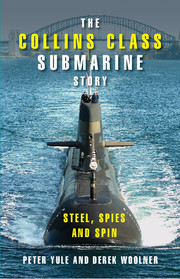Book contents
- Frontmatter
- Contents
- List of key people
- List of acronyms
- Introduction
- Part 1 You Can't Build Submarines in Australia
- 1 ‘The one class of vessel that it is impossible to build in Australia’: Australia's early submarines
- 2 Australia's Oberon class submarines
- 3 The submarine weapons update program and the origins of the new submarine project
- 4 The new submarine project
- 5 ‘We can't build submarines, go away’: Eglo Engineering and the submarine project
- 6 The acts of the apostles
- 7 ‘But how will you judge them?’: the tender evaluation process 1984–85
- 8 Spies, leaks and sackings: from tender evaluation to project definition study
- 9 The project definition study 1985–86
- 10 Debating the laws of physics: picking winners 1987
- Part 2 The Honeymoon Years 1987–92
- Part 3 ‘A Strange Sense of Unease” 1993–98
- Part 4 Resolution
- Notes
- Index
7 - ‘But how will you judge them?’: the tender evaluation process 1984–85
Published online by Cambridge University Press: 05 September 2013
- Frontmatter
- Contents
- List of key people
- List of acronyms
- Introduction
- Part 1 You Can't Build Submarines in Australia
- 1 ‘The one class of vessel that it is impossible to build in Australia’: Australia's early submarines
- 2 Australia's Oberon class submarines
- 3 The submarine weapons update program and the origins of the new submarine project
- 4 The new submarine project
- 5 ‘We can't build submarines, go away’: Eglo Engineering and the submarine project
- 6 The acts of the apostles
- 7 ‘But how will you judge them?’: the tender evaluation process 1984–85
- 8 Spies, leaks and sackings: from tender evaluation to project definition study
- 9 The project definition study 1985–86
- 10 Debating the laws of physics: picking winners 1987
- Part 2 The Honeymoon Years 1987–92
- Part 3 ‘A Strange Sense of Unease” 1993–98
- Part 4 Resolution
- Notes
- Index
Summary
There appear to have been two virtually separate histories of the new submarine project running in parallel during the mid-1980s. On the one hand there was the campaign around Australia led by Hans Ohff, John White, Graham White and Jim Duncan that put forward the submarine project as a major catalyst for industrial regeneration. On the other there were the bureaucratic processes of defence procurement among a small circle within the Department of Defence and the navy, with political involvement in the critical decisions. Within the defence bureaucracy there was great uncertainty about the submariners' requirements and the proposed purchasing strategy and little enthusiasm for building in Australia.
It was not until December 1982 that the procurement method was endorsed by the defence source definition committee, allowing the release of formal proposals to industry. However, the force structure committee, which assessed budgetary allocations, imposed strong caveats on the project. It insisted on continued investigation of the suitability of smaller submarines, and of postponing the project if the Oberons' service could be extended. Further, Alan Wrigley, the committee's chairman, insisted that Australian industry involvement should be limited. Wrigley considered that building an industry around the project unnecessarily complicated the selection processes for no good reason. He was sure that a submarine industry could not be sustained because the type of submarine the navy wanted was too big to interest foreign navies. Wrigley energetically pushed this view in the last months of the Fraser government, but the change of government in March 1983 meant that he was swimming against a fast-flowing tide.
- Type
- Chapter
- Information
- The Collins Class Submarine StorySteel, Spies and Spin, pp. 58 - 75Publisher: Cambridge University PressPrint publication year: 2008



